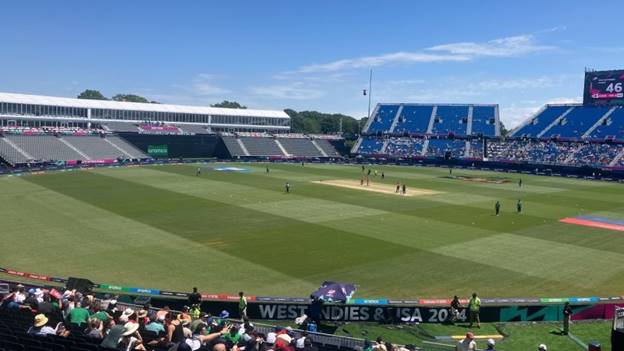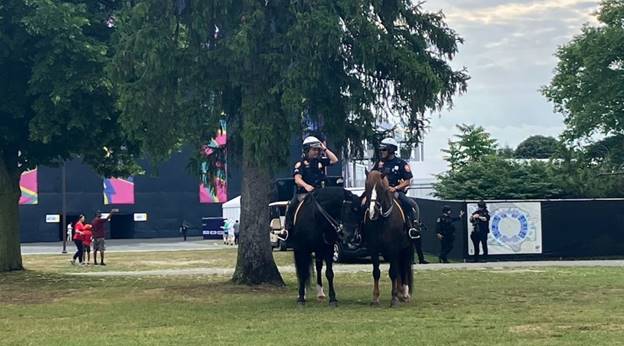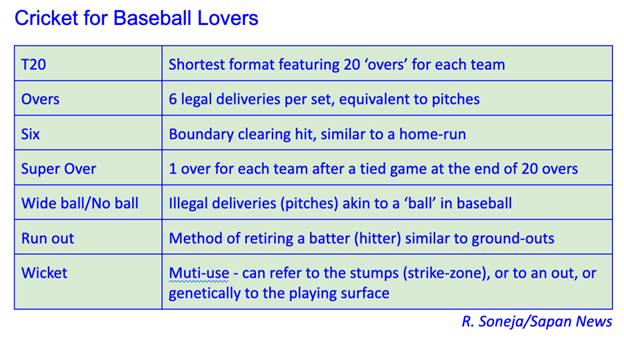
A Boston-based IT professional shares his experiences of a T20 Cricket World Cup game he attended in Long Island, New York, and thoughts on why the short format of the game, comparable to baseball, is gaining popularity in North America, identities, and who the sport ‘belongs’ to
A Colonial Pastime Brings Cricket-Lovers Together for a Chance at the American Dream
By Rajeev Soneja
Boston, MA
When Mumbai-born Saurabh Netravalkar bowled a pivotal Super Over, akin to a tiebreaker in soccer, last month he shot to fame as an American cricket hero. He also hit the perception of cricket as a snobbish colonial pastime out of the field for a six, to use a cricketing term.
Netravalkar, 32, played in India’s under-19 cricket team when it lost to Pakistan in 2010. He came to the US in 2015 to pursue a Master’s in Computer Science at Cornell University and is now an IT professional in the Bay Area.
Selected for America’s national cricket team, he has now played against his former Indian teammates – and beaten Pakistan as a member of the US team at the T20 Cricket World Cup, hosted for the first time in the USA last month.
The US team is a reflection of the country’s diversity , with home-grown players like Jones, Nosthush Kenjige, and Steven Taylor, besides the US team also includes players born in India, Pakistan, New Zealand, South Africa, and Canada.
Cricket aficionados have long dreamt of a world-beating joint Indo-Pak team. With the spread of the Southasian diaspora, that vision is a reality in many countries where players of Indian and Pakistani origin are teammates.
Several teams with diaspora populations have players with origin stories that reflect multiple identities. On the US team Aaron Jones, born in Queens to parents from Barbados, played the all-important knock, hitting 10 sixes to beat Canada to kick off the tournament.
Twenty-twenty
The T20 – or twenty-twenty (named for the 20 ‘overs’ bowled by each team) started as a marketing effort in the UK to popularise the game in the mid-2000s. It is the shortest format of the leisurely gentleman’s game traditionally played over five days.
The immense popularity of the T20 format has been enabled by numerous private leagues. Television revenues, mainly generated from the Southasian markets, have transformed it into a commercial and corporate behemoth.
This recent commercialization of the sport stems from a schism of the 1970s when Australian media personality Kerry Packer sought to sign up the world’s top players for a private commercial endeavor, considered sacrilegious by purists. The genie was out of the bottle.
Compressed into three action-packed hours, the T20 is comparable to the average length of a baseball game, more comprehensible to an American – or Canadian – audience.
Another factor in the popularisation of cricket in North America over the past decades is the rising populations of expatriates from around Southasia – Pakistan, Bangladesh, India, Sri Lanka, and even Nepal. Many come together to play cricket in vacant parking lots over weekends.
Pakistanis recreate the feeling of ‘mohalla’ playing cricket in Canada
The America-Pakistan game ended in one of the great upset wins in the sport, a truly David versus Goliath event – with America as a David for once. The US team comprising part-time players beat one of the world’s best teams, and not just historically. Based on recent form, Pakistan was considered by many commentators to be one of the favorites to do well in the tournament.
The narrative arc of Netravalkar’s life story has become an inspiration for many a Southasian family. And the performance by the first-time host country has changed the once-passing interest in the sport in America, with mainstream media outlets like GQ , NPR , and the New York Times covering the games.
The International Cricket Council (ICC), the sport’s governing body, has been promoting the game in North America, trying to reach the potential of these formerly unexplored markets.
Today, the ICC lists more than 90 countries as Associate and 12 full members. The full-member teams also compete in test matches, played over five days – the traditional long form which provides credence to the stereotype of the old-timey slow pace of the game.
This year’s T20 Cricket World Cup featured 55 games in 29 days, 16 of them in the US including eight in the Nassau County stadium in Long Island, New York, and the rest in Dallas and Florida. The remaining games were held across six different island nations in the Caribbean, that collectively play as the West Indies, a full member of the ICC.
The mega-competition, engaging millions across the world, is the second most popular sport after soccer. This year, it concluded with India winning the trophy after beating South Africa in the final last weekend.
The proximity of the venue in Long Island provided an opportunity for people like me in Boston to attend. I drove down with my teenage son for the Ireland versus Canada game in the first round. Tickets for this game were available and affordable as opposed to games that involved India or Pakistan.
I wanted my son to experience the sounds and feel for the sport that can escape while watching it on a screen. It also provided him an opportunity to be at a venue close to home having previously travelled to the UK to watch a cricket game in 2019.
If you build it they will come
The pricing and the timing of the games contradicted the noble intentions to spread awareness. Games involving India were priced for $300 apiece for the cheapest sections, not including the $40 charge for parking. Games in New York began at 10:30 a.m. which is primetime in Southasia, especially focused on the lucrative Indian TV audience.
The Eisenhower sports complex, the first completely modular international cricket stadium in the world looks like a giant Lego construction project. The entire structure, the playing surface included, has been constructed on a temporary basis to fit eight games within a 10-day period.
It was a novel collaborative effort as the playing surface, designed in Australia, was shipped to North Carolina. The turf was left to mature in Florida during the North American winter, then installed in Long Island just weeks before the World Cup.

Law enforcement from multiple agencies watch over the fans. June 7, Long Island - Photo by R. Soneja
There was strict security at all the entrances, with SWAT teams, FBI personnel and horse-mounted local police on alert. During one of the warm-up games, the methods of US law enforcement caused some dismay . When a fan ran onto the field to greet the Indian captain Rohit Sharma, multiple police officers tackled him to the ground in a manner distressingly familiar to minorities in the US. A video that went viral shows the Indian captain, joined by others, trying to stop the police.
Video posted by cricket fan Mufaddal Vohra
As we walked in, I chatted with a Staten Island-based family originally from Lahore who now belong to the Staten Island Cricket Club. One of them, Farzana, told me that their “family members are flag carriers”. She meant the teams of youngsters who carry flags of the competing teams onto the field prior to the game, as the now-obligatory national anthems are sounded.

Youth members of a local club act as flagbearers, June 7, Long Island - Photo by R. Soneja
“I had no idea what this game was about,” commented Oliver, a steward in our seating section. But he is learning the rules “and enjoying it”.
He said he didn’t want to go for the India-Pakistan game, as he had heard about the crowds and road closures.
Two seats from us, Joe, a native Long Islander sporting an Islanders NHL jersey, had brought his son, around 10 years old. Joe had first watched cricket in Australia on a visit two years ago. He lives just down the road and felt he “had to be here” for a game in his backyard.
He was planning to travel to the Caribbean for the second round of the tournament. “Come with me to St Lucia, it will be fun!”
Joe used baseball terminology to explain the game to people around us, attending their first cricket game. He described run-outs and wide balls as ‘ground outs’ and ‘strike zone’. However, he did not get into the convoluted computerised algorithm called the DLS system, used to determine results in weather-interrupted games.

Guyana-native Dennis had driven 10 hours from Toronto to watch his adopted team play. “Too bad they didn’t hold any games in Canada.”
“Wait till they find out about the DLS system!” he added with a knowing wink.
“I prefer Gaelic football,” confessed Irish-American Ron, “but I have to show up to support the home country”.
Ron’s friend, another native Long Islander was there “as a Long Island sports fan” – without his Indian-origin wife who introduced him to cricket. ”She didn’t want to come,” he grinned.
“Anything with holes and balls works for me!” exclaimed Tash, a professional pool player from Brooklyn.
The game we watched ended in a win for Canada, a forerunner of the unexpected results that turned out to be a feature of the tournament. Recently admitted to full membership, Afghanistan defeated New Zealand, and teams such as the US, Papua New Guinea, Nepal, Scotland and Netherlands created anxious moments for more prominent teams.
As we exited, I spotted a couple of fans from Toronto wearing Palestinian scarves, keffiyeh, and a Palestinian flag. Cricket really did bring a lot of people together from all corners.
As people from the Southasian diaspora find new homes in other countries, interesting questions about identity arise as their support is divided between their native and adopted countries. Or, perhaps in an ideal world, it should not matter who they support as a shared love of the game brings all kinds of people together.
(Boston-based IT professional Rajeev Soneja traveled to New York for one of the World Cup games at the first stage of the tournament. Born in Bombay, he grew up following cricket, especially during the Pakistan cricket team’s encounters.)
Note on Southasia as one word: We use ‘Southasia’ as one word, “seeking to restore some of the historical unity of our common living space, without wishing any violence on the existing nation-states” – Himal Southasian .
This is a Sapan News syndicated feature

